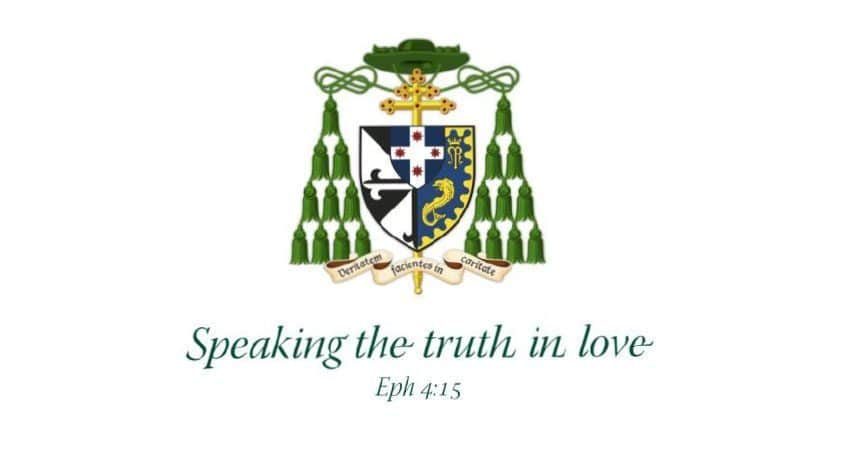HOMILY FOR THE MASS OF THE ASSUMPTION OF THE BLESSED VIRGIN MARY YEAR B

Live-streamed from St. Mary’s Basilica, Sydney, 15 August 2021
London-based Aesthetics and Anti-Aging Consultant, Cindy Jackson, was six years old when she was given a Barbie doll and she long fantasised about looking like her.[1] Suffering low self-esteem, she thought she was a beautiful person trapped in a plain person’s body and a young person trapped inside an aging shell.
Her break came in 1988, with a substantial inheritance. Fourteen major surgical procedures later, she’s a living proof that ‘60 is the new 30’. To achieve this, Cindy had her hips and thighs liposuctioned, her lips padded with fat from her bottom, and her cheeks implanted with silicone. Her eyes were twice surgically widened, her jaw broken and reset, her chin sawed down to size and her nose jobbed twice. There was cosmetic dentistry and a hair transplant. And she has annual facelifts, regular derma-brasion and Botox. It’s all been worth it, she says, for she is now ‘a living doll’ and ‘the perfect woman’ – or as near as.[2]
Paradoxically our society both worships the body and demeans it. A healthy concern for beauty and fitness becomes compulsive self-decoration, dieting and work-outs, devaluing anyone with a less-fashionable look. The body is honoured at Olympics, art, hospitals and funerals, but exploited in advertising and porn, recreational and for-profit sex. It’s abused, mutilated, drugged, aborted. On the battlefield for the human person today, the Devil hopes to gain the soul through abusing the body.
After two world wars in which crueller things were done to human bodies than ever before in history, it took a great act of faith for Pope Pius XII to declare the dogma of the Assumption[3] – a declaration, among other things, of reverence for the body.
Not every Christian has shared his appreciation of the body: a long strand in pseudo-Christian thought suggests we should hate our bodies, with their passions, needs and distractions, and eschew the physical order in favour of the spiritual. The Manichees presented body and soul as enemies, as prison and prisoner. The Cathars repudiated the physicality of sacramental worship, trivialised what we do in our bodies, and mocked hope for resurrection: it was to fight this heresy that St Dominic, who died 800 years ago this month, founded his Order of Preachers. The Puritans counselled abstinence from tasty food, alcohol, kissing, dancing – and anything else that led to smiling! Still to this day, some deny those most crucial tenets of our faith: that Christ rose in the flesh so that we may do also. Others piously talk as if the dead become ghosts or angels or spiritual stuff, casting off their material armour at last. Pious such talk is, but heresy also: for each of us is a unity in which the body is indispensable.
More than this, Scripture and Tradition celebrate the body as good (Gen 1:31). Man and woman are created in the image of a God who took flesh as man born of woman (Gal 4:4). He saved us in His earthly body (1Pet 2:24; cf. Jn 3:17; Col 1:22-24) and made our bodies temples for His Holy Spirit (1Cor 6:19-20; cf. Rom 8:9; 1Cor 12:13) through Baptism and Confirmation. He re-presents Himself bodily to us in Holy Communion, making our bodies tabernacles for His. He reconsecrates those bodies to sacred purposes by Matrimony, Holy Orders or vows of religion. And He heals them through the Unction of the Sick. Jesus’ Resurrection and Ascension is our trajectory. Hence the vigour with which the Church prophesies against anything that degrades the body or endangers life and health; hence our acceding to various restrictions in order to protect the elderly and vulnerable from a virus that targets them especially; hence our horror that the same group are now targets of euthanasia laws.
Today we celebrate the first Christian body to enter into glory: Mary is called by her Son to be with Him for ever, “for the Almighty does great things for me… and raises up the lowly” (Lk 1:39-56). No half measures in this summons: Mary now enters body and soul into the risen life of her Son. Such was the privilege of this perfect disciple whom “all generations call Blessed”. Such was the favour of the woman adorned with the heavens, whom our first reading says was taken to “a place of safety prepared for her by God” (Rev 11:19; 12:1-6,10). Such was the apostolic tradition, passed down by through the fathers and scholastics, the liturgy and saints: that the Virgin was assumed into heaven.
So Pope Pius declared that “Immaculate… Mary, having completed the course of her earthly life, was assumed body and soul into heavenly glory”. Let me focus on three points from this dogmatic decree.
First, Mary was assumed into heaven, she did not ascend there herself. Redemption is God’s work, not ours. No end of reconstructive surgery, work-outs or dieting will make our bodies perfect; nor will good works and cultivation of virtue perfect our souls. We must certainly honour and care for both. But the Assumption celebrates Christ’s work of converting, transforming, assuming us, into His body, life, destiny; assuming us ultimately into an eternity of joy with Him in heaven. Even Mary could not do this for herself. She, too, needed a Saviour, even if her unique privilege was to be saved in her very conception by a Son she had not yet conceived.
Secondly, better than any, Mary co-operated with that Son. If salvation is Christ’s work, co-operation is ours. The glory of Mary’s assumed body tells of an inner beauty. Hers was the spirit of one who said Yes when humanity so often said No. Of one who ‘magnified the Lord’, not just in song but by her whole life. Of one who carried Him in her womb and heart, and like a monstrance brought His body not just to cousin Elizabeth but to the whole world. Of one who nursed Him on her lap, taught Him all she knew, stuck by Him all the way to cross and tomb. Of one who shared in His sufferings and, in her grief, received His crucified body back into her lap – that she might offer Him once more to the Father and to us.
Mary gives back to her Creator all that any person can offer: a life lived in faith, hope and love, a life that says yes on behalf of all groaning creation (Rom 8:19-24). Through the Assumption Mary’s inner beauty is revealed to us; like Christ at His transfiguration, the glory of her soul is unveiled in the perfecting of her body.
Thirdly, to say she was the first to enter into her Son’s glory, is to intimate that she was not the last. Here is a promise of salvation for all flesh that yearns for redemption. The resurrection of the dead which we profess does not mean more of the same, an extension of our use-by date, for that would leave us as children of the first Eve, forever fragile and obsessively postponing the effects of our bondage to decay. No, the resurrection of the body means our total renewal, body and soul, and promises that, should we live this bodily life with the faith and love of the second Eve, Mary, we will join in that more glorious life with her Son and all the saints!
[1] Cindy Jackson, Cindy Jackson’s Cosmetic Surgery and Anti-Ageing Secrets (London: Cindy Jackson Ltd, 2017); https://en.wikipedia.org/wiki/Cindy_Jackson
[2] Cindy Jackson, Living Doll (London: Metro Books, 2002); Nick Watt & Suzan Clarke, “Cindy Jackson sets world record with 52 plastic surgeries, cosmetic procedures”, ABC News 5 April 2011 https://abcnews.go.com/International/cindy-jackson-sets-world-record-52-plastic-surgery/story?id=13296809; https://www.cindyjackson.com/about-cindy-jackson/
[3] Pope Pius XII, Munificentissimus Deus: Apostolic Constitution Defining the Dogma of the Assumption, 1 November 1950, https://www.vatican.va/content/pius-xii/en/apost_constitutions/documents/hf_p-xii_apc_19501101_munificentissimus-deus.html.
Welcome to St Mary’s Cathedral in Sydney, for the Solemn Mass for the Feast of the Assumption of the Blessed Virgin Mary. Last Sunday, when we Australians celebrated the feast of our national patron St Mary MacKillop, I said that it’s not often that a saint’s day trumps the Sunday celebration of Christ’s resurrection. But today we have another exception – the Assumption of the Blessed Virgin Mary – who under the title Help of Christians is the other patron of Australia. So you might say this is a double feast for Australia and, given the worsening pandemic, it is a good day on which to be commending our nation to the protection of the saints, and especially to the healing power of Christ whose Sunday resurrection grace shines in them. To everyone taking part by livestreaming, a very warm welcome!

